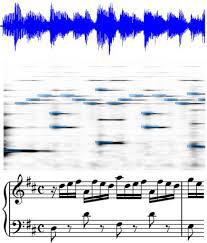Optimal spectral transportation with application to music transcription
Many spectral unmixing methods rely on the non-negative decomposition of spectral data onto a dictionary of spectral templates. In particular, state-of-the-art music transcription systems decompose the spectrogram of the input signal onto a dictionary of representative note spectra. The typical measures of fit used to quantify the adequacy of the decomposition compare the data and template entries frequency-wise. As such, small displacements of energy from a frequency bin to another as well as variations of timber can disproportionally harm the fit. We address these issues by means of optimal transportation and propose a new measure of fit that treats the frequency distributions of energy holistically as opposed to frequency-wise. Building on the harmonic nature of sound, the new measure is invariant to shifts of energy to harmonically-related frequencies, as well as to small and local displacements of energy. Equipped with this new measure of fit, the dictionary of note templates can be considerably simplified to a set of Dirac vectors located at the target fundamental frequencies (musical pitch values). This in turns gives ground to a very fast and simple decomposition algorithm that achieves state-of-the-art performance on real musical data.
PDF Abstract NeurIPS 2016 PDF NeurIPS 2016 Abstract
